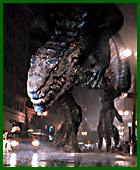Creature designer Patrick Tatopoulous re-imagines the classic King of the Monsters for a contemporary audience.
In September of 1996, a tense power meeting was underway at Toho Studios, the Japanese studio that Godzilla built. Across from Toho's Chairman, Isao Matsuoka, and several of his executives sat the Independence Day duo, director/co-writer Roland Emmerich and producer/co-writer Dean Devlin, and creature designer Patrick Tatopoulous. Although Toho owned the rights to ID4 in Japan, where the film was smashing box-office records, the executives were cautious. The visitors wanted to make the first Hollywood version of the classic Godzilla monster series. They had traveled to the Land of the Rising Sun for Toho's blessing.
Before them was the potential future of the franchise: a shrouded sculpture of the new Godzilla. At the crucial moment, Tatapolous whisked the cloth away, revealing the 15" maquette. The unveiling was met by shocked silence. "Everyone was kind of freaked out," Tatopoulous recalls. "They said, 'We need 24 hours to give you an answer.'"
It was another impasse in a long series. Godzilla had languished for a decade in development hell (most recently with Twister director Jan De Bont, ASC). Then Emmerich and Devlin, flush from the unbelievably huge response to Independence Day, resurrected the project and asked Patrick Tatopoulous, fearless designer of not one but two ID4 aliens, to reconceive the mega-monster for savvy U.S. audiences. But Tatopoulous felt a degree of apprehension about re-imagining the monster that, as a child, had inspired him to make monsters. "I was very tied up in the old design, I felt that was Godzilla," Tatopoulous admits. "I didn't even want to touch this monster. It felt more respectful to just take a new direction. Roland kept telling me, 'Patrick, please go all the way." Which is precisely what Tatopoulous did, in-between churning out Dark City designs in Australia.
Only by that time, Emmerich and Devlin were losing interest in Godzilla. That changed when Tatopoulous, armed with five unique Godzilla designs, met Emmerich in Cannes, and brought about another of the many twists in Godzilla's tortuous route to the American screen. As Emmerich flipped excitedly through his sketches, "it brought back some of the flame," Tatopoulous relates. "I made Godzilla slimmer, faster, more agile, and Roland felt we had nailed something." In gratitude, the screenwriters named Matthew Broderick's character Nick Tatopoulous.
Tatopoulous' "radically different" design attempted to capture the spirit, rather than the letter, of the beloved behemoth. Tatopoulous retained the anthropomorphic proportions of the upper body, but made the arms more rudimentary, like a Jurassic Park raptor, and gave his creature realistic tri-jointed dinosaur legs, as opposed to the twin tree-trunks of the original. While the original Godzilla's spines looked like serrated inkblots, the new spines are shaped like shark fins, thrusting forward to create "a much more aggressive profile." A massive spine anchored on each of the monster's shoulder blades gave Godzilla a winged dragon look. Tatopoulous totally re-imagined the creature's head, giving it a crocodile-like feel with massive interlocking teeth and beady eyes, then taking it toward the character realm by accentuating the cheekbones and chin. How successful was he? "If this movie had no title," Tatopoulous says proudly, "I think people would sit in the theater for 10 minutes and get the point—the movie is Godzilla."
Now it looked like Toho's turn to throw some cold water on the project. After a sleepless night, the U.S. delegation returned to the studio. Unexpectedly, Toho consented to the daring design - if they would make a few concessions to tradition. The execs wanted only four digits gracing each of Godzilla's hands and feet, as per the original and a certain number of rows of fins on the back. "The head of Toho looked at the maquette and said, 'The only problem I see is you gave Godzilla two rows of fins and our creature should only have one,'" Tatopoulous grins. "As everybody turned around to look at him, one of the other representatives made a little sign like, 'No, no, it's three rows!'" p>
[ continued on page 2 ]
